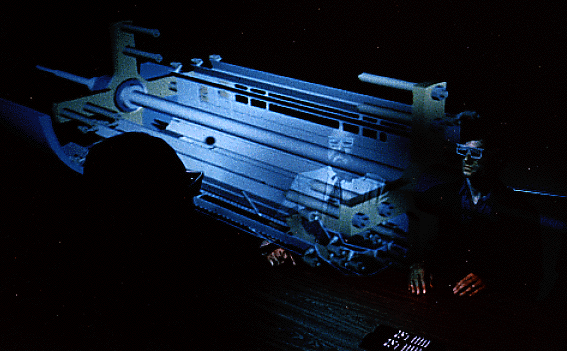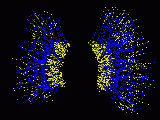
Visualization at BNL is driven primarily by the Laboratory's
long-standing programs in imaging instrumentation, from the earliest
days of the development of Positron Emission Tomography (PET), Magnetic
Resonance Imaging (MRI), and the Scanning Transmission Electron
Microscope (STEM). There are also active imaging programs utilizing the
National Synchrotron Light Source (NSLS) and other major scientific
facilities on site. Much of the visualization and analysis can be
performed independently on the researchers' desktops, but an increasing
fraction of this work is conducted in collaboration with the Computing
and Communications Division's Visualization Team using an environment
designed for that purpose.
The centerpiece of visualization at Brookhaven is a novel 3D stereo conference room viewing system. The stereo effect is achieved in a conference room setting by projecting two polarized images on a specially designed 10 foot (diagonal) screen, which is treated to retain light polarization, then viewed through ordinary polarized glasses. The image that is produced appears to be in the room with the viewer with a striking degree of realism.
The system was designed for ease of replication and high-speed network interaction. Its display is driven by a Silicon Graphics Onyx2 rack system. Among the application tools currently used are the Silicon Graphics Performer API, and IBM Visualization Data Explorer.
This facility differs from others primarily in that it provides high-resolution stereographic viewing for up to 20 individuals at once; it does not require the viewer to wear head mounted electronics, either shutter mechanisms or head tracking devices, in order to participate.

This facility has demonstrated its usefulness in a number of BNL scientific programs including the geology of oil exploration, medical imaging, structural biology, environmental science, molecular dynamics, and nuclear physics. Several of these projects are discussed in more detail below.
The facility was originally constructed for analyzing microtomographs of geological samples made at the BNL National Synchrotron Light Source as part of a CRADA with Mobil Oil. The microtomographs are used to further and improve knowledge of petroleum reservoir management.
| Medical imaging applications have produced time-dependent Positron Emission Tomography documenting the real-time behavior of cocaine in the human brain, establishing the mechanism producing the subjective 'high' experienced by drug abusers. It has also been used in an experimental radiotherapy for treating intractable malignancies, Boron Neutron Capture Therapy, where it has demonstrated usefulness in treatment planning by superimposing anatomical features (including the tumor) with radiation dose distribution. |

|
Structural Biology applications stem from the Protein Data Bank, a repository of protein structures at Brookhaven that is accessible to researchers internationally via the world wide web.

|
In the realm of Nuclear Physics, the facility has been used for a number of applications involving the development of the Relativistic Heavy Ion Collider (RHIC). It has been used to project stereographic images of the massive detectors being built for RHIC data taking. It has also been used to provide graphical output of simulations of complex RHIC events. |
Sample images from each of these applications and several others can
be found at http://www.ccd.bnl.gov/visualization/.
The Future Program & Interoperability
The future efforts in visualization fall into three areas:
Creation and manipulation of complex images can be a slow process that may prevent the potential of visualization from being realized. This is especially true for animated images (for example, for fluid flow analysis) or when there are "real time" considerations (such as when taking data). Steps have been taken to speed up the process by improving algorithms, applying parallel processing, and enhancing system hardware. More can be done in each of these areas to make the facility even more useful.
This facility was designed with distance collaborations in mind. It is network-based and readily replicable. In fact, several other institutions are either contemplating or have taken steps to build a similar one. The IBM Data Explorer package is widely used and extremely flexible in accommodating a variety of graphic formats. It is easy to envision using the Facility to analyze images produced, not at the BNL Light Source, but rather at the APS or ALS, or to have collaborators at a University videoconferencing with staff at BNL while observing the same images. To that end, Brookhaven staff welcomes any initiative to select a common graphics transfer language and develop effective collaborative tools.
We perceive three major interoperability issues. The first is agreement
on a standard exchange format. The second is presentational; when
conferencing with a similar facility, should only one theatre at a time
be displayed (as in conventional videoconferencing), or should
facilities extend to displaying two in virtual proximity (perhaps using
chroma-keying), or display multiple facilities each in its own window.
Finally, there is the question of accommodating head-positioning in a
multi-user environment. Brookhaven takes no strong position on any of
these issues; our system is expected to exhibit sufficient flexibility
to incorporate most any decision. We do look forward to the time when
these decisions are forthcoming and we can join the other sites in their
implementation.